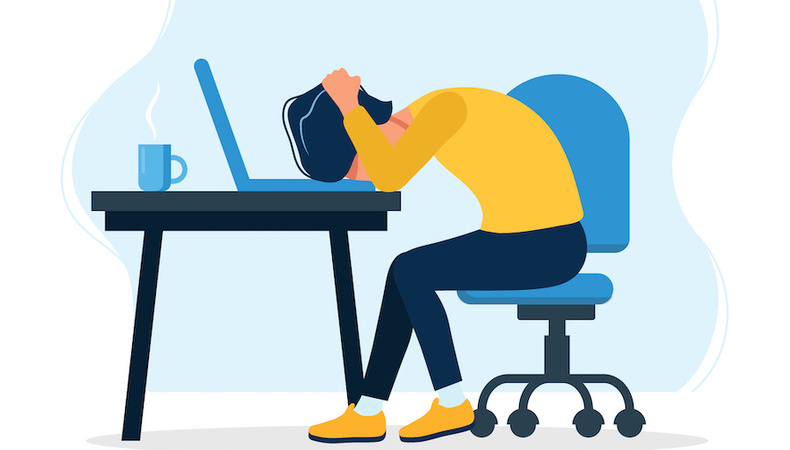Addressing ‘learned helplessness’ during the Covid-19 pandemic

Excessive workloads, anxiety about job security and a general lack of control over their situation are among the key contributing factors to this growing feeling of negativity and helplessness.
Business leaders have a responsibility to not only notice these signs of distress in their team, but also to provide timely interventions, nurturing a positive workplace that supports the emotional needs of its people.
What is ‘learned helplessness’?
Learned helplessness refers to the feeling of inability to change – or lack of control over – a situation. This happens when an individual is exposed to an environment they can’t change repeatedly or long-term. The individual eventually resigns themselves to feeling helpless over its outcomes.
This is a growing trend in the modern workplace, with employees feeling stuck in the limbo of the pandemic. This long-term uncertainty, exacerbated by the stressors of remote working or furlough, has changed the way many employees are responding to their current situation.
Many initially saw the pandemic as an opportunity to adapt to new ways of working and even relished the challenge. Now, learned helplessness, and pandemic fatigue, has seen this positive attitude turning to pessimism, frustration, lack of effort and even ‘passivity’. Here, employees lose the will to react to or try to change an ongoing, growing negative outlook. This outlook may have slightly improved due to recent government announcements, however the negative outlook and pessimism may sustain.
Many employees may have given up trying to make the best out of their situation and instead have fallen into patterns of unhelpful thinking instead – worrying ‘what if?’, instead of focusing on the aspects of their life they can control. For many, high levels of pandemic fatigue may lead to pervasive worries about the future, even with the potential for easing of lockdown measures.
These constant catastrophic thoughts can lead to feelings of long-term anxiety, low mood and depression. In turn, chronic mental ill-health can result in physical ailments too, with common symptoms including headaches, fatigue, nausea and stomach problems.
Spotting the signs
While managers cannot be expected to be medical experts – diagnosing colleagues and providing medical interventions – they do have a responsibility to notice the signs of learned helplessness and signpost those towards support.
Employees experiencing learned helplessness may find it difficult to maintain their usual levels of work performance. Not only do symptoms of chronic stress make productivity a struggle, but it can also affect concentration and motivation.
This may become obvious in an individual’s behaviour, for example, if they regularly log on late or there is a noticeable dip in their work standards. However, it may be more subtle, for example, an individual becoming quieter and more reserved, taking a negative attitude towards work or communicating less with colleagues and in meetings.
Managers noticing these changes in their team have a responsibility to support them in making positive changes. Individuals often fail to notice signs of distress in themselves, so it can help to raise awareness of how prevalent pandemic fatigue is and let employees know it’s normal to not always feel at peak mental fitness. It’s OK not to be OK.
What can you do?
Send regular emails encouraging team members to think about their emotional wellbeing. Focus on ‘wellness’ rather than ‘illness’ to normalise the idea that everyone’s mental fitness dips from time to time – especially during difficult situations – and there are steps they can take to get back to full fitness.
This messaging could include questions such as ‘how could you improve your mental health?’ which can help employees achieve the lightbulb moment of realisation they might need additional support.
It also helps if those in more senior positions share their experiences when it comes to mental distress. Consider sharing directors’ and managers’ stories about their experiences and the interventions they use to return to their maximum mental fitness.
These stories show it’s possible to take control of your emotional wellbeing and that they don’t have to let these feelings simply ‘happen’ to them.
Plus, it helps reduces stigma in the workplace, showing even those seen as ‘mentally strong’ can experience distress and unhelpful thinking.
Providing workplace support
Those managing individuals who are showing signs of learned helplessness must try to help them ‘thrive’. This refers to the feeling of emotional resilience and mental energy which comes from making helpful changes and adopting positive thought patterns. Simple techniques can help.
Begin by offering clarity about expectations, letting employees know they aren’t expected to work longer hours or skip lunch just because they’re at home and no longer commuting. This helps employees set boundaries and reduces the risk of stress and burnout from overwork. Encourage them to get out of the house, for a walk or even just stand in the fresh air.
Other helpful advice includes encouraging employees to avoid ‘doomscrolling’ – constantly scrolling social media for negative stories – and practice mindfulness techniques.
Another way to improve mental health is by improving physical health. Managers should promote the benefits of exercise and daylight during lunch breaks and encourage healthy eating – possibly by offering fresh food vouchers.
Managers can then let employees know there’s additional support on offer via the business. For example, offering remote access to psychotherapy sessions (such as CBT) lets employees speak confidentially with a therapist who can help them work through challenging difficulties and emotions.
Similarly, online self-help CBT courses help individuals recognise and understand their unhelpful behaviours and negative thinking patterns.
Instead of focusing on the statistic ‘1 in 4 people’ have mental ill-health, we should raise awareness of the fact ‘3 in 4 people’ have mental health and mental health is much more than the absence of mental ill health. Mental health can be nurtured and improved upon.
Consider emotional literacy training or emotional wellbeing manager training to equip those on the front line with the skills to identify signs of mental ill-health in others and the confidence to support them.
Finally, all leaders have a responsibility to notice their own signs of distress and take care of themselves so they are ready to notice and intervene to support others.
The author is Brendan Street, head of charity, Nuffield Health.
Article is provided by Nuffield health.
Supplied by REBA Associate Member, Nuffield Health
Nuffield Health are the UK's largest healthcare charity & the market leader in corporate healthcare.







